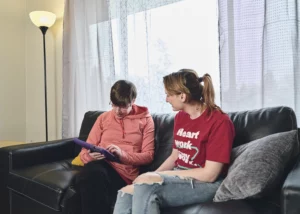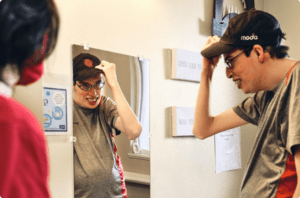Explore the ALSO Children’s Homes Wishlist and help fill the season with joy for the children supported by ALSO.
Explore the ALSO Children’s Homes Wishlist and help fill the season with joy for the children supported by ALSO.


In health support services, terms are used to help evaluate a person’s ability to perform tasks related to everyday life. Two of the most common terms are IADL and ADL. When you hear these terms, this is what they refer to:

To better understand what IADLs are and to get a clearer picture of what is involved in IADLs, it’s helpful to review common examples.
Examples of IADLs include tasks such as:
This IADL involves things such as paying bills on time, adhering to a budget, understanding cash flow, balancing a checking account, handling pocket money, understanding currency, using primary math skills, managing assets, etc.
This IADL involves tasks such as monitoring home repair needs, washing dishes, cleaning floors and furniture, tidying up, organizing possessions, arranging for professional repairs/maintenance, operating a thermostat/air conditioning unit, etc.
Communication is an IADL that covers a broad range of activities, such as calling utility companies, banks, landlords and more. Also included is the ability to communicate with doctors and to express problems or ask questions in a coherent manner. Today, it also involves the use of technology such as emails, texting and using a smart phone. It also includes being able to communicate with medical emergency agencies if needed.
Medication management is an IADL that includes being able to take prescribed medication on time and at the correct dosage. Also, keeping track of when medication has already been taken, self-monitoring for reactions/side effects, requesting refills before running out of medication, and even keeping prescription medication in a safe place where visiting relatives—such as children—can’t access it.
As you can infer from these examples, these IADLs and others require advanced abilities that go beyond simple, everyday tasks, such as ADLs.
ADL is an acronym that stands for Activities of Daily Living. This category of activities relates to self-care that is more connected to health and survival.
Unlike IADLs, ADLs are essential aspects of daily life. They consist of a minimum of tasks that must be completed in order for an individual to be healthy and have their basic needs met. Most people engage in ADLs every day without even thinking twice about their ability to do so. By the time a person has reached the kitchen in the morning, they’ve typically already:
For others, completing ADLs requires more effort, concentration and/or assistance. Our nonprofit provides individuals with ADL services when needed.

To better understand ADLs and to get a clearer idea of their importance, it’s helpful to consider the most common examples.
Examples of ADLs include activities like:
Being able to move from one place to another, using whatever means is possible. This may mean walking, using a walker, a cane or a wheelchair. This ADL also includes the ability to roll over/change position in bed or in chair to provide for physical comfort. Mobility is crucial for many reasons, including keeping joints active, movement of the body, accessing food and water, reaching out for help via telephone or a door buzzer, accessing toilet and bathing facilities and even leaving a room where the person’s life is in danger (i.e., a fire breaks out, etc.)
This ADL entails the ability to open the mouth, chew and swallow nutritious food. It also entails the ability to keep the food down to allow the body to properly digest it.
This ADL entails the ability to ingest liquids from a cup, straw or spoon, and the ability to swallow liquids and to keep the liquids down.
This includes the ability to use soap and shampoo to wash the face, body, and hair. It also includes having the physical capability to bend and stretch limbs and hands in order to reach the areas of the body that need to be washed.
This ADL entails being able to manipulate textiles in a manner that the person can dress themselves. This includes using buttons and zippers, pulling a garment over the head, pushing arms through sleeves, etc.
This ADL encompasses the ability to sit on a toilet seat, extract bodily fluids and waste, and clean the private bodily parts afterward.
Grooming is an ADL that involves brushing teeth, cleaning and inserting dentures and/or bridges, combing or brushing hair, clipping fingernails and/or toenails, cleaning ears, applying deodorant as needed, etc.
This category of ADL is often overlooked, but it includes managing minor conditions such as a light cold that does not require a doctor’s care. It includes the ability to use a tissue to blow the nose, wipe the eyes, apply a compress to the forehead for a headache, etc.
There are distinguishing differences between IADLs and ADLs, as outlined in the lists of examples above.
IADLs are activities that are commonly associated with adulthood and personal responsibility. For example, children do not need to engage in IADLs because they are taken care of by parents or guardians. For that reason, IADLs are not considered to be mandatory in life. However, IADLs enable an individual to have a level of freedom and independence, in addition to personal growth, without help from others.
That is not to say that individuals who can’t manage IADLs cannot have those things. IADLs are not considered essential to daily life, because it is possible to get assistance with IADLs.
Those who can’t manage IADLs can still enjoy freedom, independence and personal growth. The difference is that those individuals will need support from an organization like ALSO. ADLs are activities that are considered indispensable for survival. Without ADLs, an individual would certainly need disability support services.
Evaluating IADLs and ADLs in persons with disabilities is a crucial step in determining what services they need. This type of assessment helps physicians, caregivers, family members and outside agencies to make decisions that will directly impact the individual’s quality of life and access to needed resources.
IADLs and ADLs assessments are even used by agencies such as Medicaid, Medicare, and insurance companies to inform which services will be paid for in full or in part.
Therefore, IADL and ADL determinations have great significance for people with disabilities and their loved ones.

At ALSO, we support individuals with developmental and intellectual disabilities in a variety of ways, including both IADLs and ADLs. We adhere to what we call a “wrap around” approach to supporting an individual’s needs. Another way to look at it is comprehensive, whole health support where needed.
Our services include, but are not limited to:
We do not subscribe to a “one-size fits all” approach. Instead, we work closely with medical professionals and family members to tailor a customized support program that best matches a person’s needs at that time.
An important aspect of the disability support services at ALSO is the ongoing re-evaluation of needed support. It’s very common for needs to change and grow or decrease over time. An individual may gain skills that mean they no longer need certain services. Minimizing support in that area is important to allow for increased confidence and feelings of independence for that individual.
On the other hand, as a disabled individual’s condition progresses, either through aging or progression of a disease, they may need more services as time goes on.
ALSO is ready to pivot, adjust and be flexible to an individual’s changing needs. This is what we mean when we say we are ready to help as needed. We believe in choice. We believe in supporting independence and freedom as much as possible. We believe in our mission to promote the full inclusion of people experiencing disabilities in the life of their community, and we believe that everyone has a right to quality of life.

Sign up for our newsletter to get our latest news, content, and job opportunities.
Help us ensure that everyone has the same opportunities in their home, workplace and community. Let’s make dreams!
